The church's history, which existed between 1931 and 1951 and was officially known as the Regnum Marianum (Land of Mary), or Magna Domina Hungarorum (Lady of Hungary), is closely connected with the past of the Regnum Marianum community. The Regnum Marianum, as a Roman Catholic community, a spiritual movement for the evangelisation of young people, was founded nearly 125 years ago.
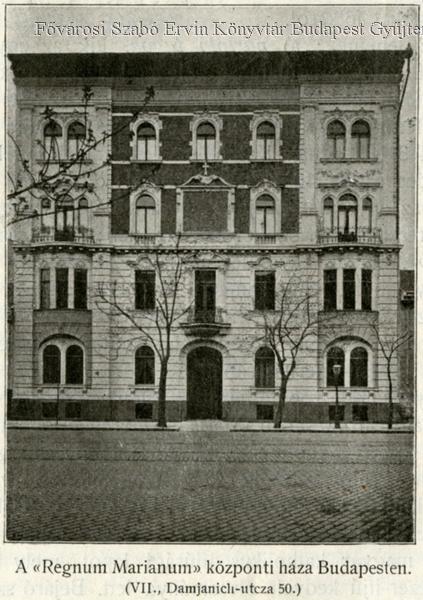
The central house of the Regnum Marianum at 50 Damjanich Street in 1904 (Photo: FSZEK Budapest Collection)
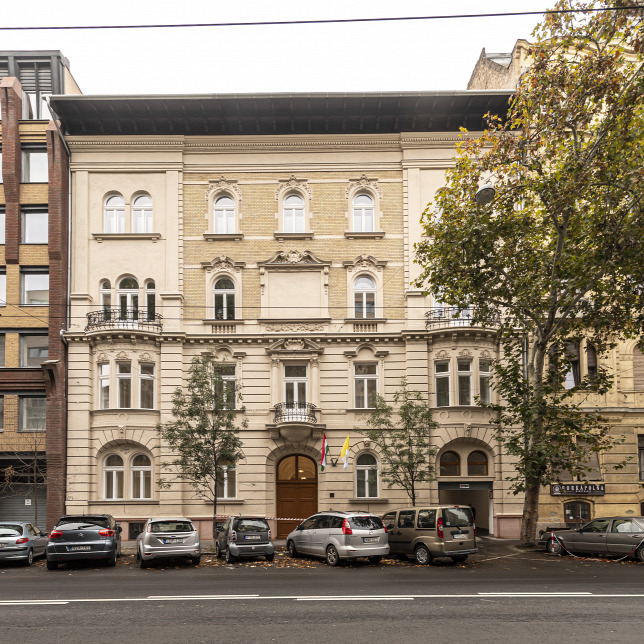
The former headquarters of Regnum Marianum was renovated in 2019 (Photo: MTI / Zsolt Szigetváry)
The predecessor of the organisation was created in 1896 by Ottokár Prohászka (1858-1927), a theological teacher, later the county bishop of Székesfehérvár under the name Philippinum. The choice of name paid homage to the child rescue work of St. Philip Neri (1515-1595). Count Gusztáv Károly Majláth (1864-1940), Bishop of Transylvania, bought the three-storey tenement house at 50 Damjanich Street in Erzsébetváros from his family's private property in 1901 for the priestly community, which at that time was already called Regnum Marianum. The primary goal of the organisation was the evangelisation of young people in Budapest, especially in Erzsébetváros. A large chapel was built on the ground floor of the building.
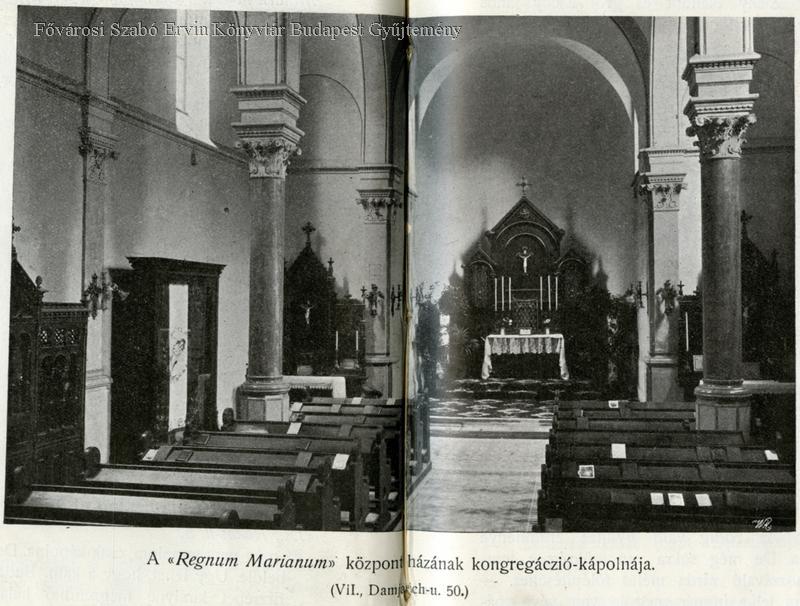
The chapel of the central house of the Regnum Marianum at 50 Damjanich Street in 1904 (Photo: FSZEK Budapest Collection)
During the anti-church period of the Hungarian Soviet Republic, in 1919, the situation changed when Archbishop János Csernoch separated the outer part of Erzsébetváros, also called Csikágó, from the territory of the St. Elizabeth of Hungary Parish in Erzsébetváros. As a result, the Regnum Marianum Chapel was declared an independent parish church. After the fall of the communist dictatorship, fundraising could begin in the early 1920s to build a larger church. Much of the fundraising work was undertaken by Lajos Shvoy (1879-1968), the first parish priest in the new parish, who even went to the United States to obtain sponsors for the church building. In 1923, the capital of Budapest, as a benefactor, provided an area for construction on the edge of Városliget.
The collection of donations was helped by the fact that the "House of God" was intended not only as the most important sacred building of the parish community but also as a kind of votive, "church of gratitude" built as a result of Hungary's liberation from the 133 days long dictatorial rule of the Hungarian Soviet Republic.
The plan of the architect Iván Kotsis (1889-1980) was chosen for the church to be built on the edge of the Városliget, in the axis designated by Damjanich Street. At the laying of the foundation stone, on 10 October 1925, the church service was performed by Cardinal Prince Primate János Csernoch; Governor Miklós Horthy also honoured the event with his presence. Following the "first hoeing" ceremony on 26 July 1926, concrete construction work began on 11 August.
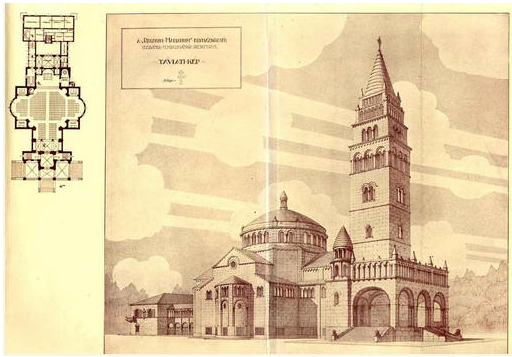
Blueprint from 1925, architect: Dr Ivan Kotsis
.jpg)
The new church of the Regnum Marianum Parish to be built on a contemporary postcard, 7 February 1927.
The church reached its highest height in two years. It took another three years to complete the construction. The solemn inauguration of the "House of God" began with the ordination of the bell on 14 June 1931. Jusztinián Serédi (1884-1945), Cardinal, Archbishop of Esztergom, blessed the more than two hundred kilograms St. Imre bells before the church's consecration ceremony. The casting - like the imposing 54-meter, imposing tower in the original plans was not completed - was placed in a much smaller structure 16 meters high.
.jpg)
Prince Primate Serédi consecrates and recites the first Mass in the new Regnum Marianum church (Source: Picture appendix of the Magyarság, 21 June 1931)
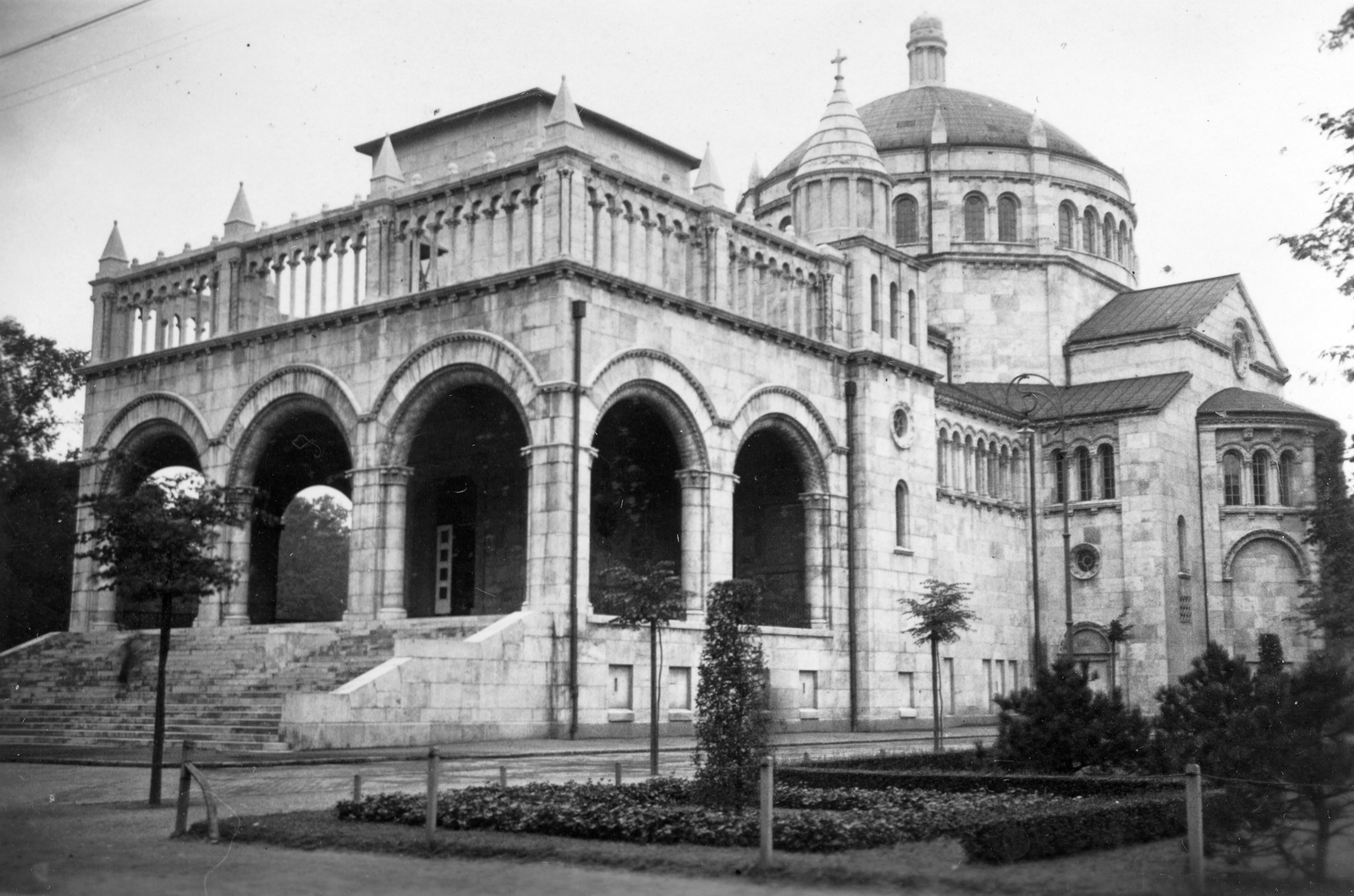
The Church of the Regnum Marianum in 1936 (Photo: Fortepan / No.: 39262)
The only bell of the church was cast not in honour of the patron saint of the church, but in memory of St. Emeric, the holy prince of the Árpád House, because in the period, especially in the St. Emeric memorial year in 1930, the cult of the son of St. Stephan was lively among Hungarian Catholics. The consecration of the bell was followed by the liturgy of the consecration of the church, led by the archbishop. The St. Emeric bell - at that time put in its final place - was sounded first at the height of the solemn Mass, at the ritual of the elevation of the host.
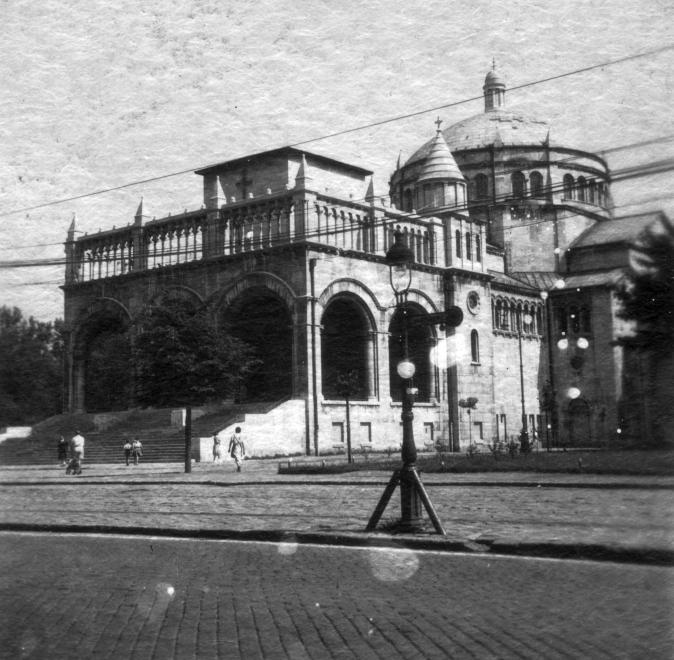
The Church of the Regnum Marianum in 1935 (Photo: Fortepan / No.: 62270)
The modern materials of the church and the medieval motifs of the church consecrated by Cardinal Serédi showed that it tried to contrast the sad reality of the present, the peace treaty of Trianon imposed on Hungary and the related economic difficulties, with recalling the glorious past of Hungarian sacred architecture. The chosen medieval atmosphere of the church simultaneously indicated the commitment of Hungarian Christianity to the Western Roman Catholic Church and its connections to the ecclesiastical world of the Eastern Byzantine rite.
In Iván Kotsis's final but not fully completed plan, the 54-meter-high tower would have appeared as a powerful vertical architectural sign in addition to the medieval, Romanesque-style dome similar to those in southern France and northern Italy.
From Damjanich Street, the observer, looking at the formal design of the building, could think not only of the southern French predecessors but also of a simplified version of the basilicas of Venice or Padua.
Regnum Marianum attracted attention with its dimensions, but it could not "compete" with other Christian churches built in its surroundings at the dawn of the 20th century due to the lack of sufficient financial resources. The Parish Church of the Queen of Rosary in Istvánmező and the Parish Church of St. Elizabeth of Hungary in Erzsébetváros both represent the richness of an earlier flourishing period, dualism, both in their external appearance and their rich internal ecclesiastical decoration. The Protestant communities of Erzsébetváros built outstanding buildings in the Városligeti Avenue, as diligent Pest citizens with significant wealth could be found among their supporters.
The exterior of the Regnum Marianum, even without the imposing bell tower, revealed a unified, consciously thought-out intent by the architect. Inside, the much simpler space did not evoke the Middle Ages, but in its "puritanical" representation - even if the scarcity of financial resources shaped it - the possibility of modern, metropolitan church architecture emerged.
The natural geographical constraint, the swampy, marshy soil layer of Városliget, required the architect to place the church square above street level. There was an opportunity to build a large sub-church under the church, which was considered necessary by both the architect and the parish. In the metropolises of the United States, due to high land prices, this solution was used for better space utilisation; The Reformed Church in Rákosfalva was the first in Hungary to be built with such a layout between 1928 and 1929.
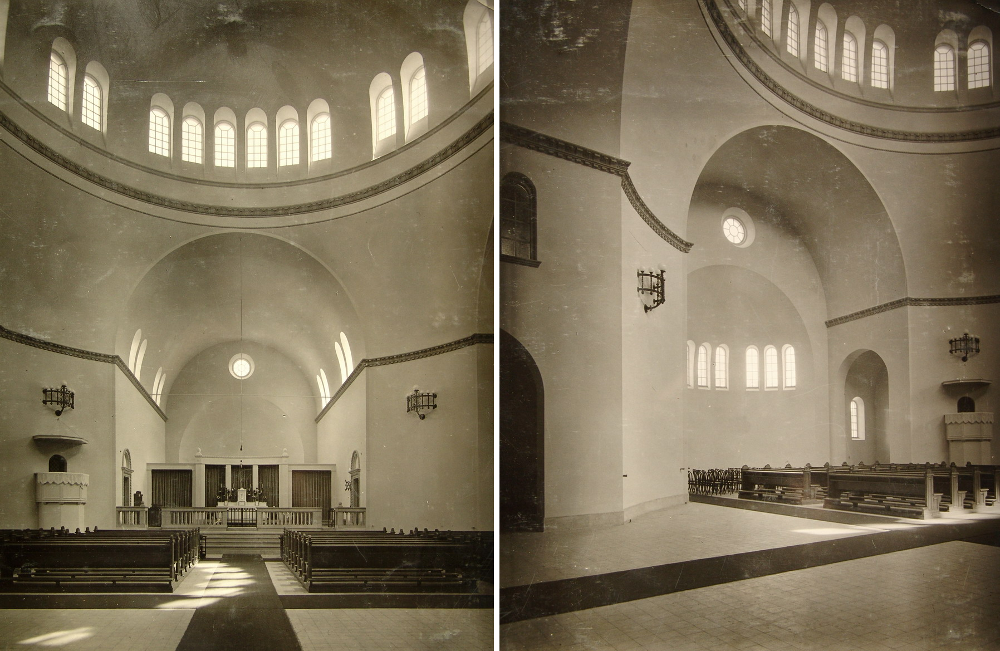
The simple, puritan interior of the church no longer evokes the Middle Ages (Source: Community of Hungarian Patriots)
In the absence of a large bell tower, the flat-arched dome placed on a high dome drum was the most prominent architectural element of the Regnum Marianum's external appearance. A simplified copy of the Hungarian Holy Crown rose in the centre of the dome. Since the cross was not distorted at the 25-meter-high point of the church, unlike the Hungarian Holy Crown, the cross here referred to both royal symbols at the same time, to the Globus Cruciger of Hungary in addition to the Holy Crown.
The Hungarian Holy Crown symbolised the nearly thousand-year-old Christian Hungary, which was fragmented after World War I by the constraint of victorious powers, but the nation's unity remained despite the new "country formations". The Holy Crown has been displayed several times on buildings commissioned by state offices or state-owned companies. For example, the central part of the main façade of the Nyugati Railway Station is still decorated by it in a prominent place to this day.
The new dome of the Budavár Palace, designed by Alajos Hauszmann (1847-1926), was decorated from 1905 to 1945 with a copy of the Hungarian Holy Crown, which symbolised not only historical Hungary but also in the absence of the ruler - as Franz Joseph, and after him, Karl IV rarely stayed in the Buda Palace - the king himself.
Budapest's most famous public work that uses the Holy Crown symbol is the Gabriel Archangel Statue of the Millennium Monument. While the sculptor György Zala referred to the legend associated with the coronation of the first Hungarian king, St. Stephen, by depicting the Holy Crown in the case of the statue decorating the centre of the Heroes' Square, the Holy Crown ornament closing the dome of the Regnum Marianum church can be interpreted otherwise by a perceptive observer.
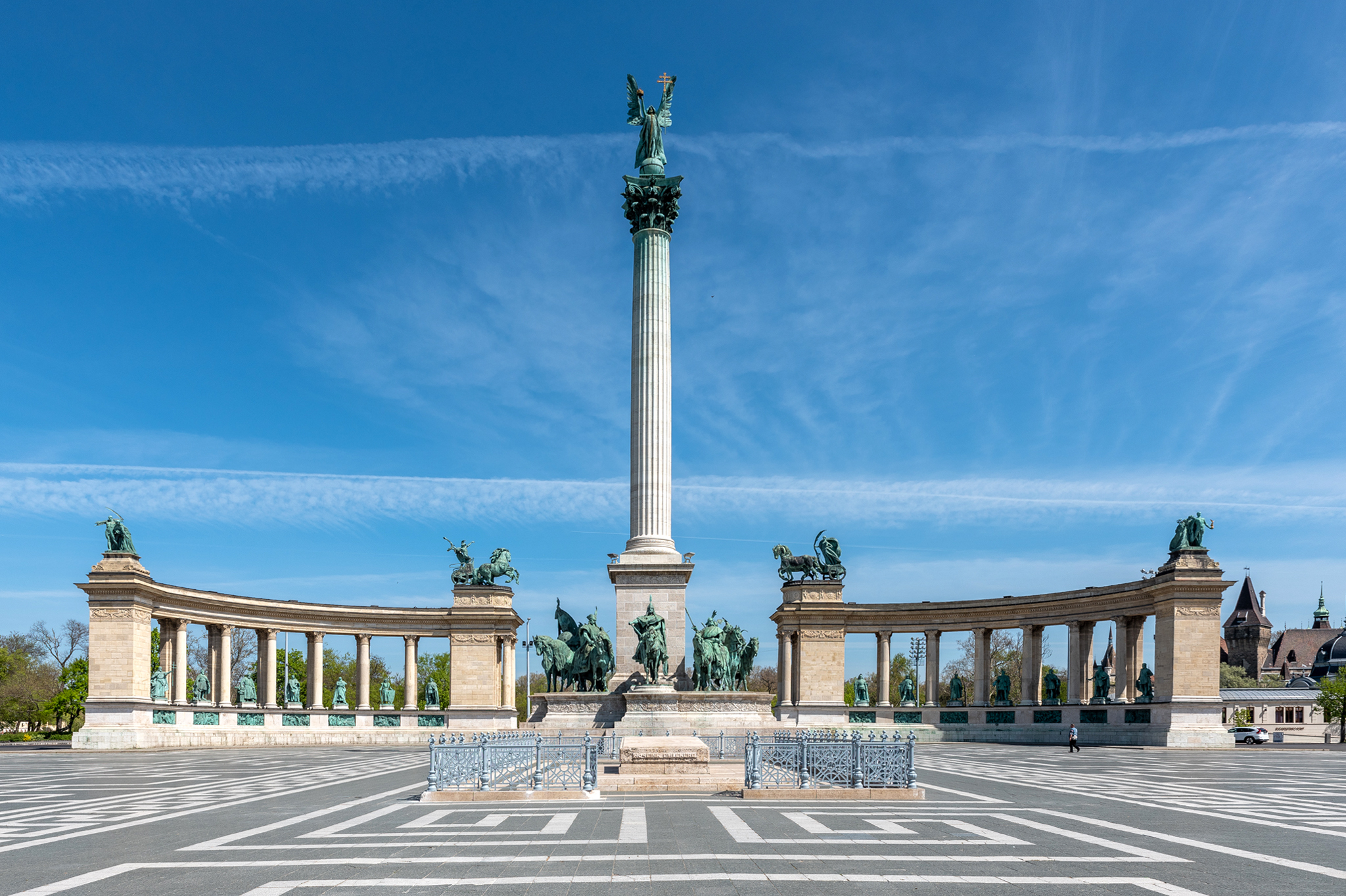
At the top of the column in Heroes' Square is a statue of Archangel Gabriel (Photo: Balázs Both / pestbuda.hu)
According to the centuries-old tradition, the Holy Crown, connected to St. Stephen and preserved in the dome hall of the Parliament since 2001, is a unique symbol in the history of the Hungarians. According to the idea, the Holy Crown also touched the head of the first Hungarian king, St. Stephen, therefore the display of the crown - which is in its present state is younger than the time of King Stephen - became a permanent attribute of the ruler.
The king's son, Emeric, suffered a fatal injury in 1031 during a game hunt. In the absence of a male successor, according to the Hartvik legend, the ruler offered Hungary to the Virgin Mary for protection on 15 August 1038, before his death. Over the centuries, based on the offer of St. Stephen, the peculiar cult of Mary as the Lady of Hungary developed in the spirituality of Hungarian Catholicism. In the year of the Millennium, 1896, Pope Leo XIII, at the request of the Hungarian Episcopal Faculty, authorised the holy day of the Lady of Hungary.
It was already present in fine art in the Baroque era, but especially in the period of dualism, the land offering of St. Stephen was depicted with the Hungarian Holy Crown, so it can be seen in the altarpiece of the painter Gyula Benczúr (1844-1920) for St. Stephen's Basilica.
In the case of the Regnum Marianum, the symbol symbolising both the Holy Crown and the Globus Cruciger indicated that Hungarian Catholicism hoped for spiritual renewal by returning to the values set by St. Stephen.
The church, consecrated in 1931, began to be called the Great Regnum by the common language of Pest, as the chapel on Damjanich Street, which was called the Little Regnum, continued to operate. The Little Regnum fell victim to the bombings of World War II, while the Great Regnum was demolished in 1951 by the Rákosi era for reasons of town planning. Its destruction was a symbolic act of persecution. A simple cross has marked its location since 1992.
After the regime change, Cardinal Archbishop László Paskai established the Regnum Marianum parish on a new territory on 1 January 1991. The construction of the new parish church in Zoborhegy Square, in Alsórákos in the 14th district, started in 1995, based on the plans of Attila Illés-Kreutzer. The ornament of the main façade, the 33-meter blade tower, carries several symbols. Its height refers to the time of Jesus' earthly life. His upper part symbolises the flame of the Holy Spirit. The building, completed after one year of work, was blessed on 6 October 1996 by Cardinal László Paskai.
.jpg)
The Regnum Marianum Parish Church in Alsórákos, consecrated in 1996 (Photo: Róbert Juharos / pestbuda.hu)
In 1999, three bells were placed in the tower cast by Lajos Gombos (1928-2011) in his workshop in Őrbottyán. In addition to the two sacred spaces, the building also houses several community and exhibition spaces, where for two decades, from 1996 to 2016, in addition to everyday objects of old times, ecclesiastical monuments, ceramics made in the Zsolnay factory in Pest and the legacy of the painter Ferenc Lohr - which came from the collection of the parish priest György Hajnal - could be seen.
As a young man attached to Regnum, the parish priest, who served until 2016, was present at the demolition of the reinforced concrete church in 1951, following the path of the trucks carrying the remains of the ruined building by bicycle, thus witnessing adequate information on where they were buried. The church garden features architectural details from the old Regnum church, which were excavated under the direction of György Hajnal.
Cover photo: The Regnum Marianum Church in the 1930s (Photo: FSZEK Budapest Collection)

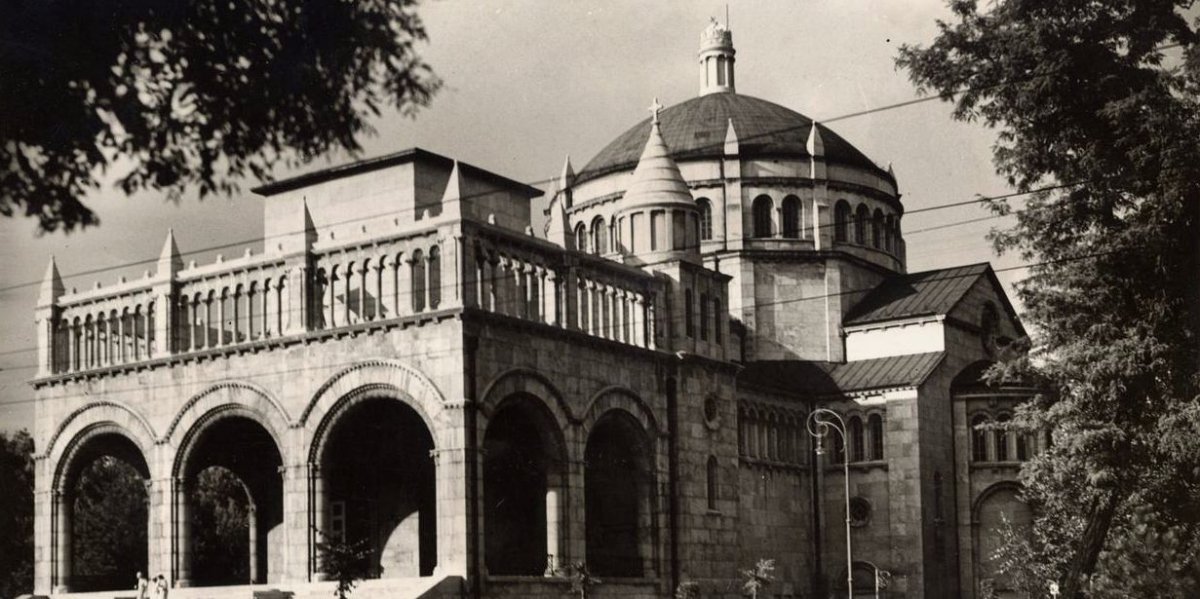



































Hozzászólások
Log in or register to comment!
Login Registration